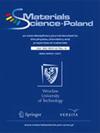Structures and Electronic Properties of Titanium Oxo Clusters with Tartrate Ligand: A Density Functional Theory Study
IF 1.1
4区 材料科学
Q3 Engineering
引用次数: 0
Abstract
Titanium oxo clusters are considered a model for nanotitanium dioxide and have gradually become a new field of functional materials in solar cells. In this work, the precise structural information of two types of tartrate-based titanium-oxo clusters was investigated by quantum chemical approaches. Density functional theory (DFT) and time-dependent density functional theory (TDDFT) calculations provided the precise structural parameters of Ti4(C4H2O6)(AS)2(OiPr)10 and Ti4(C4H2O6)(ATS)2(OiPr)10. Our work provided reliable results in agreement with the experimental results. In both molecules, the Ti-O bonds were mainly divided into three categories: the bonds in the first category were the coordination bonds between the central skeleton Ti atom and the tartaric acid group, whose bond lengths were 2.000 – 2.080 Å; the bonds in the second category were the coordination bond formed by the Ti atom and the oxygen on the AS ligand sulphonic acid group, whose bond lengths were 2.148 – 2.310 Å; the bonds in the third category were the Ti-O bonds with shorter bond lengths, which were the coordination bond formed by the Ti atom and the oxygen on the isopropylalkoxy group with their bond lengths in the value range from 1.777 Å to 1.795 Å. These kinds of Ti-O bonds also can be found in other Ti4 titanium-oxo clusters. Molecular orbitals showed that electron transfer from the AS/ATS ligand to the {Ti4} central skeleton was induced by sunlight with maximum UV-Vis absorption of 605/629 nm. Our calculation results provide strong guidance for the discovery of new efficient titanium oxo in solar cells.酒石酸钛氧簇合物的结构和电子性质:密度泛函理论研究
钛氧簇被认为是纳米二氧化钛的一种模型,已逐渐成为太阳能电池功能材料的一个新领域。本文采用量子化学方法研究了两种酒石酸盐基钛氧团簇的精确结构信息。密度泛函理论(DFT)和时变密度泛函理论(TDDFT)计算提供了Ti4(C4H2O6)(AS)2(OiPr)10和Ti4(C4H2O6)(ATS)2(OiPr)10的精确结构参数。我们的工作提供了与实验结果一致的可靠结果。在这两个分子中,Ti- o键主要分为三类:第一类键为中心骨架Ti原子与酒石酸基团之间的配位键,键长为2.000 ~ 2.080 Å;第二类键为AS配体磺酸基上Ti原子与氧形成的配位键,键长为2.148 ~ 2.310 Å;第三类键为键长较短的Ti- o键,是由Ti原子与异丙烷氧基上的氧形成的配位键,键长在1.777 Å ~ 1.795 Å之间。这些类型的Ti-O键也可以在其他Ti4钛氧团簇中发现。分子轨道表明,在最大紫外-可见吸收为605/629 nm的太阳光下,电子从AS/ATS配体转移到{Ti4}中心骨架。我们的计算结果为在太阳能电池中发现新型高效氧化钛提供了强有力的指导。
本文章由计算机程序翻译,如有差异,请以英文原文为准。
求助全文
约1分钟内获得全文
求助全文
来源期刊

Materials Science-Poland
工程技术-材料科学:综合
CiteScore
1.70
自引率
18.20%
发文量
0
审稿时长
6.2 months
期刊介绍:
Material Sciences-Poland is an interdisciplinary journal devoted to experimental research into results on the relationships between structure, processing, properties, technology, and uses of materials. Original research articles and review can be only submitted.
 求助内容:
求助内容: 应助结果提醒方式:
应助结果提醒方式:


